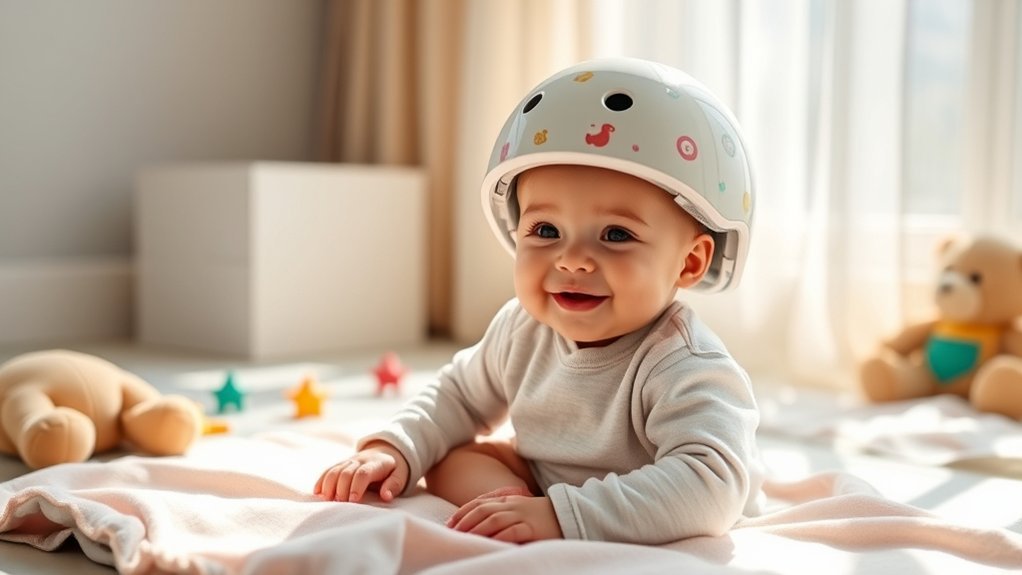Did you know that about 1 in 2 infants can develop positional plagiocephaly? This common condition can arise from spending too much time in one position. If you notice any flat spots on your baby’s head, it’s essential to contemplate interventions like a baby helmet. Understanding how and when to introduce these helmets can greatly influence your child’s head development and overall safety. Let’s explore the key aspects of baby helmets and their preventive benefits.
Understanding the Purpose of Baby Helmets
Baby helmets are specifically designed to protect infants from developing flat spots on their heads, a condition known as positional plagiocephaly.
These helmets work by gently reshaping the skull as your baby grows, helping to promote even head development. When your infant spends extended time in one position, it can lead to uneven pressure on certain areas of the skull.
By using a baby helmet, you can effectively reduce the risk of these flat spots, ensuring your child has a well-rounded head shape.
It’s important to remember that early intervention is vital for ideal results. While the thought of a helmet might seem intimidating, it’s a proactive step toward your baby’s healthy development, allowing you to support them during this critical growth phase.
When to Introduce a Baby Helmet
Knowing when to introduce a baby helmet can greatly impact your child’s head shape development.
Generally, it’s best to take into account a helmet between 4 to 6 months of age, as this is when your baby’s skull is most malleable. Early intervention is vital; the sooner you address any concerns, the better the potential outcomes for your child’s head shape.
If you notice any flat spots or asymmetry, consult your pediatrician. They can assess your child’s condition and recommend the appropriate timeline for helmet therapy.
Choosing the Right Baby Helmet
Choosing the right baby helmet is essential for effective treatment and comfort. Start by consulting your pediatrician or a specialist to determine the appropriate helmet type for your baby’s specific needs.
Look for helmets made from lightweight, breathable materials that offer proper ventilation, guaranteeing your baby stays comfortable during use. Ascertain the helmet fits snugly but isn’t too tight; it should allow for growth while providing adequate support.
Check for adjustable straps that make it easy to secure without causing discomfort. Finally, consider the helmet’s design—colorful options may make wearing it more appealing for your baby.
A well-chosen helmet can promote healing and help your little one feel more at ease during the treatment process.
Tips for Safe Play With Baby Helmets
While your little one adjusts to wearing a helmet, it’s important to guarantee their play environment is safe and conducive to exploration. Keep an eye on their surroundings and confirm that play areas are free of sharp objects and potential hazards.
Here are some tips to enhance safety during playtime:
| Tip | Description | Safety Benefits |
|---|---|---|
| Supervise Play | Always watch your baby during play. | Prevents accidents and confirms safety. |
| Soft Play Surfaces | Use padded mats or soft grass for play areas. | Reduces impact from falls. |
| Encourage Gentle Play | Promote calm activities that minimize collisions. | Decreases the risk of injury. |
Alternative Safety Measures for Infants
As your baby becomes more mobile, exploring their surroundings can lead to unforeseen risks, even with a helmet on. To enhance safety, consider creating a secure play environment.
Use soft mats and cushions to reduce impact when your infant falls. Make sure sharp objects and hazardous materials are out of reach. Baby-proof your home by covering electrical outlets and securing furniture to prevent tipping.
Supervision is essential; always keep an eye on your little one during playtime. Additionally, teach them safe play habits, like avoiding climbing on unstable surfaces.
Regularly assess their environment for potential dangers, as your baby’s mobility will continuously evolve. By implementing these safety measures, you can help protect your infant while fostering their curiosity and independence. Furthermore, incorporating tummy time into your baby’s routine encourages motor skills development and strengthens essential muscles.
Frequently Asked Questions
Can Baby Helmets Be Customized for My Child’s Head Shape?
Yes, baby helmets can be customized to fit your child’s unique head shape. Specialists create individualized designs, ensuring comfort and effectiveness. It’s crucial to consult with a professional for the best fitting option for your child.
How Long Should My Baby Wear the Helmet Each Day?
Your baby should typically wear the helmet for 15 to 23 hours daily, depending on their specific needs. Consistent use promotes effective reshaping, so it’s important to follow your pediatrician’s recommendations for ideal results.
Are There Any Side Effects of Using Baby Helmets?
Yes, baby helmets can cause minor side effects like skin irritation or discomfort. However, these issues are usually temporary and manageable. Regular checks and adjustments help guarantee your baby’s comfort throughout the treatment process.
How Do I Clean and Maintain a Baby Helmet?
To clean and maintain a baby helmet, use mild soap and water, gently scrub with a soft cloth, and rinse thoroughly. Avoid harsh chemicals. Regularly check for cracks or wear to guarantee safety and effectiveness.
What Should I Do if My Baby Resists Wearing the Helmet?
If your baby resists wearing the helmet, try introducing it gradually. Make it a fun experience with playtime or distractions. Comfort and reassurance help ease their anxiety, so be patient and consistent during this adjustment period.
Conclusion
In conclusion, introducing a baby helmet can be a gentle step toward ensuring your little one’s head develops beautifully. By monitoring head shape and consulting your pediatrician, you’re taking proactive measures for your child’s well-being. Remember to create a cozy play environment and encourage safe exploration, allowing your baby to thrive while wearing their helmet. Embrace this journey, as it’s just a small part of nurturing your child’s growth and happiness.
